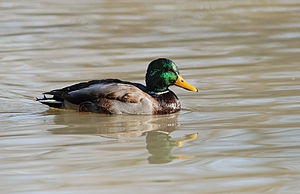 Image via Wikipedia
Image via Wikipedia
KDWPT waterfowl reports help hunters even when water is scarce
PRATT — Duck seasons in the High Plains and Low Plains Early zone are in full swing, and it won’t be long until hunters are able to pursue their favorite waterfowl statewide. The good news is that record numbers of waterfowl should be migrating through the state, but drought has persisted throughout the summer and into early fall, making Kansas Department of Wildlife, Parks and Tourism (KDWPT) waterfowl management areas more important than ever.
PRATT — Duck seasons in the High Plains and Low Plains Early zone are in full swing, and it won’t be long until hunters are able to pursue their favorite waterfowl statewide. The good news is that record numbers of waterfowl should be migrating through the state, but drought has persisted throughout the summer and into early fall, making Kansas Department of Wildlife, Parks and Tourism (KDWPT) waterfowl management areas more important than ever.
KDWPT offers waterfowl reports on its website,www.kdwpt.state.ks.us. Reports on waterfowl numbers, migration status, habitat conditions, hunting success, and phone and email contacts are provided for major public waterfowl hunting areas in the state’s five regions. Waterfowl numbers at these areas can change overnight, so it is recommended that hunters phone area offices for the latest information.
Hunters should note that duck season does not begin in much of central and eastern Kansas until Oct. 29, and not until Nov. 5 in the Southeast Zone (new this year). Consult the KDWPT website or the 2011 Kansas Hunting and Furharvesting Summary for details on dates and zone boundaries.
Peak migration is still far north of Kansas, but hunters are finding ducks in many areas. As of mid-September to mid-October, KDWPT wildlife areas list the following reports:
Region 1 (northwest Kansas)
- Cedar Bluff — fair hunting conditions but no flooded shoreline vegetation and about 200 ducks;
- Glen Elder — fair hunting conditions, exposed mud flats, and approximately 3,000 ducks;
- Jamestown — good hunting conditions with approximately 500 ducks;
- Lovewell — reservoir 1.3 feet below conservation pool with very few ducks at this time;
- Norton — good hunting conditions with some flooded vegetation and about 600 ducks at this time;
- Smoky Hill/Kanopolis — poor hunting conditions and only about 100 ducks;
- Webster — water level is about 6.1 feet below conservation pool with only a few ducks; and
- Wilson — good flooded vegetation and several hundred puddle ducks.
Region 2 (northeast Kansas)
- Benedictine — good habitat conditions with about 500 teal and some bigger ducks;
- Clinton — low water and poor hunting conditions with few ducks;
- Hillsdale — low water and fewer than 100 ducks;
- Jeffery Energy Center — poor hunting conditions and few ducks;
- Milford — habitat and food resources scarce in most wetland areas with few ducks on the area;
- Perry — fair to good hunting conditions with about 640 ducks; and
- Tuttle Creek — 400-500 ducks but marshes will be full at opener.
Region 3 (southwest Kansas)
- Cheyenne Bottoms — pools 3B and 4B have been flooded, and 20,000-30,000 are reported;
- Isabel — main lake full but others dry with about 50 teal and gadwall; and
- Texas Lake — good hunting conditions with about 300 ducks.
Region 4 (southcentral Kansas)
- Byron Walker — very dry hunting conditions with no ducks reported at this time;
- Cheney — poor hunting conditions with about 45 teal reported as of Sept. 23;
- Council Grove — fair hunting conditions but few ducks so far;
- El Dorado — poor hunting conditions with no ducks ;
- Kaw — few ducks and poor hunting conditions;
- McPherson Valley Wetlands — fair habitat but little water and few ducks;
- Slate Creek — no ducks and poor hunting conditions; and
- Marion — poor hunting conditions and no ducks.
Region 5 (southeast Kansas)
- Elk City — hunting conditions fair but few ducks as of Sept. 20;
- Fall River — good hunting conditions with about 100 ducks as of Sept. 19;
- John Redmond — poor hunting conditions as of Sept. 8 with few ducks;
- Marais des Cygnes — should have fair hunting conditions by late October, 2,000-5,000 ducks reported;
- Melvern — fair hunting conditions but few ducks as of Sept. 22;
- Neosho — fair habit conditions with approximately 650 ducks; and
- Toronto — good hunting conditions but fewer than 100 teal as of Sept 19.
Much more detail is available on the waterfowl reports pages for each of these areas, and as the weather cools and ducks begin moving south in greater numbers, many areas reporting poor conditions could turn into waterfowl hotspots if they receive rainfall. Visit these pages regularly to keep abreast of water conditions and migrations as they unfold. Duck season dates and zones include the following:
- High Plains Zone — Oct. 8-Jan. 2, 2012, and Jan. 21-29, 2012;
- Low Plains Early Zone — Oct. 8-Dec. 4, and Dec. 17-Jan. 1, 2012;
- Low Plains Late Zone — Oct. 29-Jan. 1, 2012, and Jan. 21-29, 2012; and
- Low Plains Southeast Zone — Nov. 5-Jan. 8, 2012, and Jan. 21-29 2012.
Canada goose season (includes Brant) runs Oct. 29-Nov. 6 and Nov. 9-Feb. 12, 2012. White-fronted goose season runs Oct. 29-Jan. 1, 2012, and Feb. 4-12, 2012. Light goose season runs Oct. 29-Nov. 6 and Nov. 9-Feb. 12, 2012, and a light goose conservation order allows hunting through April 30, 2012.


No comments:
Post a Comment